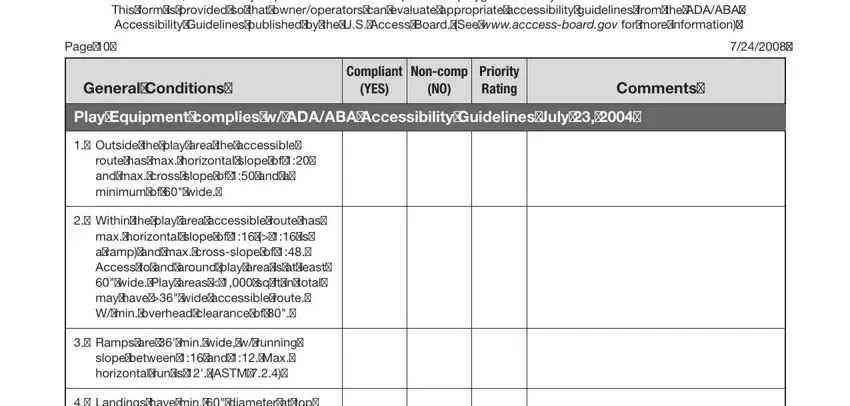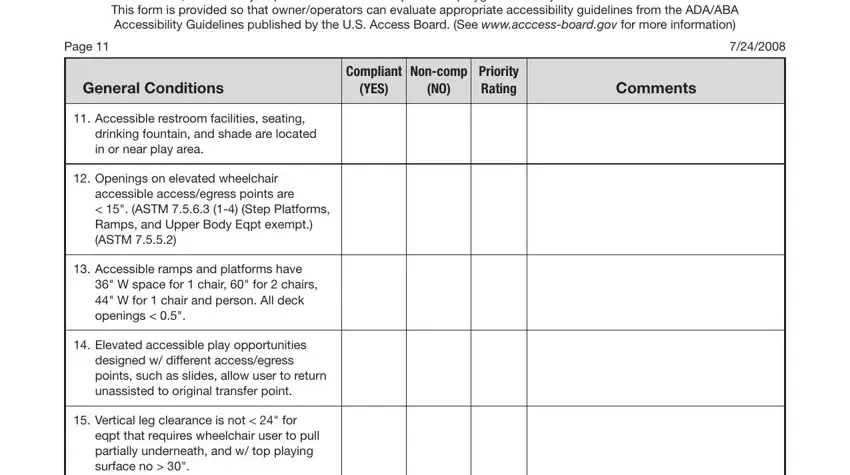Playground Safety
Compliance Audit Form
Playground Name/ID Number ______________________________________________
Injuries to children may occur from many types of playground equipment and environmental con-
ditions. The checklist on the following pages will help you to assess and correct safety concerns
that may be present on or near your playground. While it does not cover every potential safety con-
cern in a children’s environment, it is an overview of most known playground safety concerns. The
checklist does not apply to home playground equipment, amusement park equipment, or to equip-
ment normally intended for sports use. The checklist also does not address the many important is-
sues of child development that pertain to play.
The playground safety compliance audit form is not a regulatory standard, but a compilation
of suggested guidelines based upon the Public Playground Safety Handbook written by the U.S.
Consumer Product Safety Commission (CPSC)1 Revised April 2008, American Society for Testing
and Materials (ASTM)2 F1487-07ae¹ Standard, ADA/ABA Accessibility Guidelines July 20043 and
expert opinions from individuals with a vast amount of experience in the field of playground safety.
Acknowledgments:
•Created from the “Statewide Comprehensive Injury Prevention Program” (SCIPP), Department of Public Health, 150 Trecost Street, Boston, MA 02111
•Adapted as Wheaton Park District’s “Initial Playground Safety Audit” September, 1989, Revised December 20, 1990 and November, 1991, Ken Kutska, CPRP
•Edited and updated June, 1992, by Ken Kutska, CPRP, and Kevin Hoffman, ARM, Park District Risk Management Agency
•Edited and updated March, 1998, by Ken Kutska, CPRP, CPSI; Kevin Hoffman, ARM, CPSI, and Tony Malkusak, CPRP, CPSI
•Edited and updated March, 1998, by Ken Kutska, CPRP, CPSI; Kevin Hoffman, ARM, CPSI, and Tony Malkusak, CPRP, CPSI
•Edited and updated March, 2003, by Ken Kutska, CPRP, CPSI; Kevin Hoffman, ARM, CPSI, and Tony Malkusak, CPRP, CPSI
•Excel™ formatted 2004, revised citations to 2008 CPSC Handbook and ASTM F1487-07ae¹ Standard, August, 2008, by Steve Plumb, CPRP, CPSI
•Revised September 2008 by IPSI, LLC, Ken Kutska, CPRP, CPSI, Executive Director
1.U.S. Consumer Product Safety Commission, (CPSC), 4330 East West Highway, Bethesda, MD 20814
2.American Society for Testing and Materials (ASTM), 100 Barr Harbor Drive West Conshohocken, Pennsylvania 19428
3.U.S. Access Board, 1331 F Street, NW, Suite 1000, Washington, DC, 20004
Revised 09/08 ©2009 IPSI, LLC
©
1 |
©2009 International Playground Safety Institute, LLC |
Playground Safety Audit Forms
Background Information
Page 1
IMPORTANT: This information has been prepared to assist the agency’s attorney in defending potential litigation. Do not release to any person except an agency official, insurance representative, or an investigating police officer.
Play Area: __________________________________________________________ |
Date: __________________________ |
Eqpt Type: __________________________________________________________ |
Surface: _______________________ |
Audited By: _________________________________________________________ |
Intended User Age: _____________ |
|
|
General Environment
1. Category of Playground: (circle all that apply)
Community Park |
Public School |
Daycare Center |
Neighborhood Park/Tot Lot |
Private School |
Other: ______________________ |
2.Equipment Inventory: (indicate the number of equipment pieces that exist)
A. Composite Structures |
B. Freestanding Eqpt |
C. Site Amenities |
|
|
stairways/step ladders |
_______ |
swings (to-fro) |
_______ |
benches |
_______ |
|
stairways/step ladders |
_______ |
rotating swings |
_______ |
tables |
_______ |
|
rigid climbers |
_______ |
seesaws |
_______ |
fountains |
_______ |
|
flexible climbers |
_______ |
slides |
_______ |
bike racks |
_______ |
|
decks/platforms |
_______ |
rigid climbers |
_______ |
wheelchair parking |
_______ |
|
play panels |
_______ |
flexible climbers |
_______ |
signs |
_______ |
|
slides |
_______ |
upper body eqpt |
_______ |
litter barrels |
_______ |
|
sliding poles |
_______ |
rocking eqpt |
_______ |
fencing |
_______ |
|
horizontal ladders |
_______ |
merry-go-round |
_______ |
other |
_______ |
|
horizontal rings |
_______ |
spinner (< 20" D) |
_______ |
other |
_______ |
|
track rides |
_______ |
sand play area |
_______ |
|
|
|
crawl tunnels |
_______ |
backhoe digger |
_______ |
|
|
|
clatter/other bridges |
_______ |
play panels |
_______ |
|
|
|
ramps |
_______ |
stepping pods |
_______ |
|
|
|
transfer stations |
_______ |
net climber |
_______ |
|
|
|
roofs |
_______ |
other |
_______ |
|
|
|
other |
_______ |
other |
_______ |
|
|
|
other |
_______ |
other |
_______ |
|
|
|
|
|
|
|
|
|
|
|
|
|
|
|
Revised 2008 IPSI© |
|
|
3 |
|
©2009 International Playground Safety Institute, LLC |
General Environment (continued)
3. Playground Perimeter Concerns
Directions: Circle all potential concerns that exist, and indicate the actual distance item is from play area border. Evaluate each item with owner against KEY below. Items located within 100’ of playground should be evaluated for possible mitigationn.
Page 2 |
|
7/21/2008 |
|
|
|
|
|
|
|
Distance |
Priority |
|
|
Playground Perimeter Concerns |
from Border |
Rating |
Comments |
|
|
|
|
|
|
1st public street |
|
|
|
|
|
|
|
|
|
2nd public street |
|
|
|
|
|
|
|
|
|
3rd public street |
|
|
|
|
|
|
|
|
|
4th public street |
|
|
|
|
|
|
|
|
|
streets with heavy traffic |
|
|
|
|
|
|
|
|
|
water (ponds/streams/ditch) |
|
|
|
|
|
|
|
|
|
soccer/football field |
|
|
|
|
|
|
|
|
|
baseball/softball field (home plate) |
|
|
|
|
|
|
|
|
|
basketball court |
|
|
|
|
|
|
|
|
|
parking lot |
|
|
|
|
|
|
|
|
|
railroad tracks |
|
|
|
|
|
|
|
|
|
trees (not pruned up at least 7’) |
|
|
|
|
|
|
|
|
|
golf course |
|
|
|
|
|
|
|
|
|
quarry |
|
|
|
|
|
|
|
|
|
contaminated area/landfill |
|
|
|
|
|
|
|
|
|
other (specify) |
|
|
|
|
|
|
|
|
|
other (specify) |
|
|
|
|
|
|
|
|
|
other (specify) |
|
|
|
|
|
|
|
|
|
|
|
4 |
©2009 International Playground Safety Institute, LLC |







